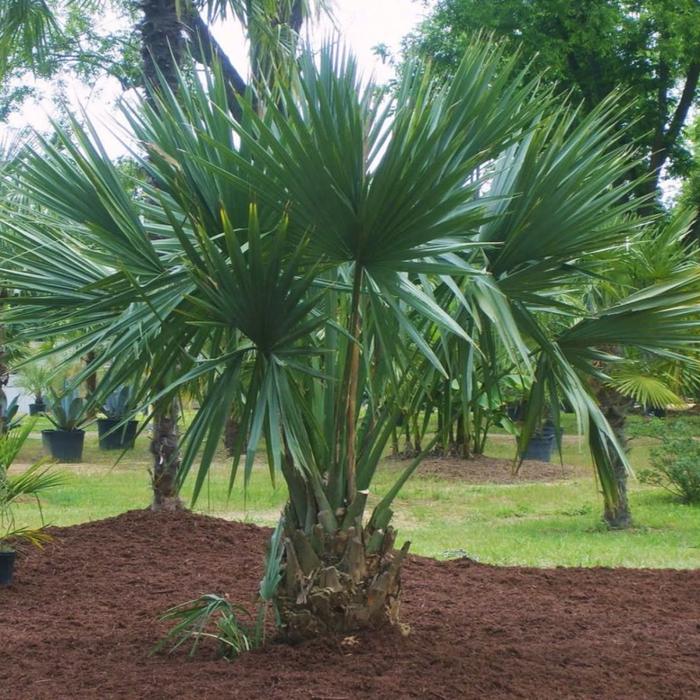
The first hurdle to overcome when dreaming of gracing your landscape with a touch of the tropics is realizing you can grow palm trees year-round in northern sections of Georgia. You have various choices in those producing both fan-shaped and feathery fronds that take the area’s cold winter weather like champs. Palms not only add beauty to the area but can also increase your home’s value and our Atlanta palm tree nursery has a wealth of cold-hardy choices available.
Once you’ve conquered that first hurdle and chosen the palms that fit your desires, you’re probably wondering when is the best time to plant and how to plant your palm tree. Although planting during some seasons produces faster growth than others, you can basically plant year-round provided winter’s lows aren’t uncommonly severe.
Planting in Spring
In the wonderful world of plants, spring is the time of rebirth and new growth. Both air and soil temperatures are on the rise during this time promoting both foliage and root growth. Spring encompasses the months of March through May and is considered the traditional planting season. Below are the average high and low temperatures in the Atlanta region during these months:
- March: 65℉/44℉
- April: 73℉/51℉
- May: 80℉/60℉
With all the warmth blanketing the region after winter and new growth taking place, it goes to reason that springtime is a great time to plant your new palms in the landscape. By the time winter rolls around your palm has established itself in its new planting site.

Planting in Summer
By the time the months of summer roll around the warmer conditions have taken hold of the region. As in spring, summer is a time your palm will put on the most active growth both in its foliage and root development. As a bonus, the rainy season has taken hold, which adds even more benefits for planting a new palm during this time.
Summer includes the months of June through August and the average temperatures for the Atlanta region during this time are listed below:
- June: 87℉/67℉
- July: 89℉/71℉
- August: 88℉/70℉
Planting your palm in summer is another perfect time as you’re guaranteed new growth both above and below the ground. The added benefit of seasonal rain nourishes the root system with moisture, which in turn cuts down on its irrigation needs. By the time winter weather arrives your palm has started a good establishment in the planting site.
Planting in Fall
Fall encompasses the months of September through November and although temperatures have started to cool a bit it’s still a great time to plant your palm into the landscape. The palm is still producing active growth during this time, which allows the root system to begin its establishment in the planting site.
Although rainy conditions have subsided a bit during this time, warm conditions are still present. The average fall temperatures for the Atlanta region during the months of fall are listed below:
- September: 83℉/65℉
- October: 73℉/53℉
- November: 64℉/43℉
Planting your palm tree during fall is another great time as the tree still has time to start establishing itself in its new planting site before winter arrives.

Planting in Winter
Although you might not consider winter a great time to plant your palm tree when dealing with cold-hardy varieties it’s still a suitable time as the trees tolerate the area’s average winter temperatures including the lows, given they do not drop below the plant’s minimum cold-hardy levels. Rainy conditions also increase during this time of the year meaning you’ll have to water less frequently..
A bonus for planting your cold-hardy palm during the winter months is you actually “beat the rush.” Fewer people are searching for palms at this time of year so you’ll get the best pick of the litter. You’ll already have your palms planted in place by the time the growing season of spring arrives.
Like the vast majority of plants, palms go through a period of dormancy in winter where growth slows both above and below the ground. Therefore, don’t be concerned if after planting you don’t witness new growth until spring when warmer conditions return.
Our cold-hardy palms can handle various degrees of drops in temperature, depending on the specie. Please check the palm you are buying and make sure the cold-hardy tolerance for that particular palm and size correspond to those in your grow zone. The average winter temperatures for the winter months of December through February include:
- December: 55℉/37℉
- January: 53℉/33℉
- February: 57℉/37℉
The only time you wouldn’t want to plant your new palm during winter is if extreme winter conditions are on the horizon. If wind, snow, and freezing temperatures are predicted to be something not normally experienced throughout the region you’ll want to delay planting until conditions return to normal.
Know Your Palm Tree’s Cold Hardiness

When selecting a cold-hardy candidate and a permanent location to plant it, it’s best to familiarize yourself with the palm’s tolerances. You’ll want to know the lowest temperatures the palm tolerates without suffering damage. Getting to know your chosen palm tree and its likes and dislikes assures you are planting and growing a healthy tree for years to come.
Although all our cold-hardy palms tolerate cold weather to varying degrees, some tolerate more extreme winter temperatures than others.
Our cold-hardy palms can handle various degrees of drops in temperature, please check the palm you are buying and make sure the cold- hardy tolerance for that particular palm and size correspond to those in your grow zone. The average winter temperatures for the winter months of December through February include:
Below are the cold-hardy palms and other plants you can find at Atlanta Palms and the temperatures they tolerate in winter:
- Blue Agave Havardiana: Hardy to -20℉
- Needle Palm: 10°F with short drops to 0℉
- Windmill Palm: 10℉ with short drops to 0°F
- Dwarf Palmetto Palm: 10°F with short drops to 0°F
- Sabal Palm: 20°F with short drops to 10°F
- European Fan Palm: 20°F with short drops to 10°F
- Pindo Palm: 20°F with short drops to 10°F
- Green Saw Palmetto: 20°F with short drops to 10°F
- Silver Saw Palmetto: 20℉ with short drops to 10°F
- King Sago Palm: 20°F with short drops to 15°F
Selecting a Suitable Location for Cold Hardiness
Another important factor when choosing a good location to plant your palm is knowing how conditions in the proposed planting area are affected by cold temperatures. You can give your newly planted palm tree an extra layer of winter protection by planting it in a suitable location. Survey your landscape for not only the palm’s preferred growing conditions but also a suitable area that offers the tree a bit more protection from an unexpected blast of extreme winter temperatures, if needed.
There are a variety of conditions that affect an area in the landscape’s winter temperatures, which in turn affect the cold hardiness of your palm tree, including the palm itself. How successful a palm weathers an extreme cold snap include:
- The average low temperatures the palm naturally tolerates.
- The age and general health of the palm, as older established palms and those given good care, withstand a freak cold snap better than those that aren’t.
Landscape Conditions Affecting Cold Hardiness
All landscapes have microclimates that affect how well your palm weathers extreme winter conditions. This is why it’s important to survey the area before deciding on the best place to plant your new cold-hardy palm.
If you want to plant your new cold-hardy palm in a location where it’s given the most protection during winter consider the following:
- Planting the palm in a sheltered location close to a structure or where it’s surrounded by other plants gives the palm more protection during winter.
- Elevations are another factor to consider. Cold temperatures congregate in low-lying areas so you might want to plant in the highest area of your landscape.
Additionally, because most palms can weather drought, this gives them a better chance to withstand an extremely cold winter. Most cold-hardy palms are native to regions where dry and wet seasons are very distinct. Freezing stress is similar to drought stress, as it affects the palm’s ability to intake water. This ability to withstand low water conditions gives the cold-hardy palm the ability to withstand cold conditions.

Give the Palm Extra Cold Protection
Freak weather occurrences happen regardless of the season. If you’re worried your newly planted palm might suffer damage, you can take some steps to help protect it from severe winter conditions.
- Saturate the root system with water the day before the severe conditions are expected. The water helps keep the root system warm and insulates it.
- Apply a thick layer of organic mulch over the planting site to help insulate the root system and keep it warm.
- If the palm isn’t too tall, you can protect its heart by covering the palm with burlap or sheets to help keep the tree warm. You can also hang holiday lights throughout the canopy or place a light under the cloth covering.
- If your palm is still in a container you can group it around other plants or bring it indoors to a protected location until the extreme conditions leave the area.
Atlanta Palms is here to help you select the perfect palm for your particular landscape and design dreams. We will also assist in planting your cold-hardy palm to assure it gets off to the best start possible. Remember, regardless of the season and whether it’s spring through winter, you can plant your new cold-hardy addition year-round. Before you know it you’ll be enjoying your private tropical paradise.
Frequently Asked Questions about Planting Palm Trees
When to plant palm trees?
Planting during some seasons, like spring or summer, produces faster growth than others. However, you can plant palm trees year-round provided winter’s lows aren’t too severe.
When is the best time to plant a palm tree?
While spring or fall may traditionally be the best time to plant trees, there are many cold-hardy palm trees that can be planted in the winter in Georgia if you’re looking to add a tropical paradise to your home during cold and gloomy months.
How to replant a palm tree?
Replanting a large palm tree can be difficult, as some trees grow 30+ feet high. Transplanting palms to a larger pot, however, is something you could do more easily. If you have questions about your palm tree, call 770-400-9897.









